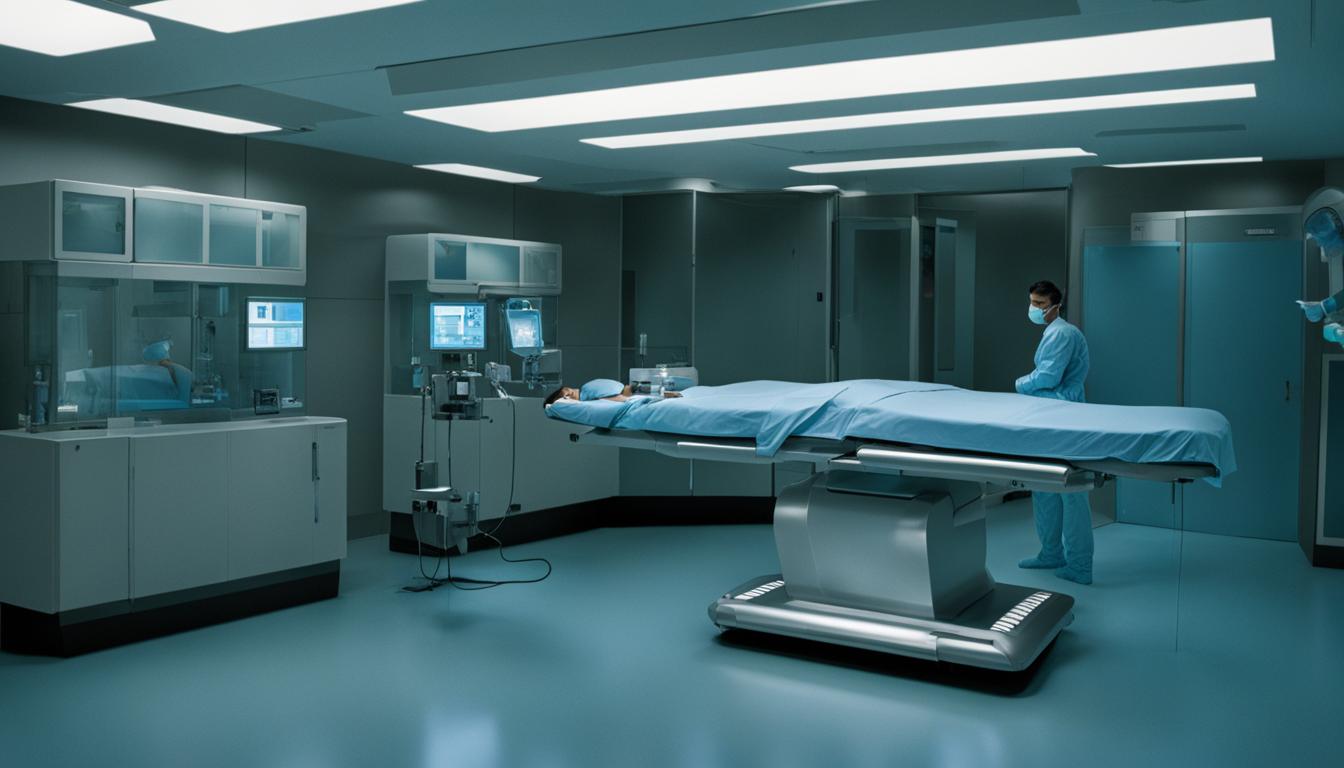Prostate cancer is a serious health concern that affects many men. Fortunately, there are effective treatment options available, and one of the most common approaches is radiotherapy. This article aims to provide a comprehensive understanding of prostate cancer radiotherapy sessions, including the different types of radiation therapy, factors that affect the number of sessions, potential side effects, and overall treatment goals.
Radiotherapy is a targeted treatment that uses high-energy radiation to kill cancer cells and shrink tumors. It can be used as the primary treatment for early-stage prostate cancer, in combination with other therapies for more advanced cases, or to manage symptoms in advanced cancer. The specific approach to radiotherapy depends on the individual patient’s situation and the recommendations of the healthcare team.
There are several types of radiation therapy commonly used for prostate cancer. These include external beam radiation therapy (EBRT), brachytherapy (internal radiation therapy), and proton beam radiation therapy. Each type has its own advantages and considerations, and the choice of treatment depends on various factors, such as the cancer stage, treatment goals, and the expertise of the healthcare team.
During radiotherapy sessions, patients are carefully positioned to ensure the accurate delivery of radiation to the prostate gland. The number of radiotherapy sessions for prostate cancer can vary depending on factors such as the stage of the cancer, treatment goals, and the specific radiation technique used. It is important to note that the treatment plan is personalized to the individual patient to ensure the best possible outcome.
Key Takeaways
- Radiotherapy is a common treatment for prostate cancer.
- There are different types of radiation therapy, including external beam radiation therapy, brachytherapy, and proton beam radiation therapy.
- The number of radiotherapy sessions depends on various factors, such as the stage of the cancer, treatment goals, and the specific radiation technique used.
- Potential side effects of radiotherapy include bowel and urinary problems, erection problems, fatigue, and lymphedema.
- Discussing treatment options with the healthcare team is essential to making informed decisions about prostate cancer treatment.
Types of Radiation Therapy for Prostate Cancer
When it comes to treating prostate cancer, there are several types of radiation therapy available. The main options include:
- External Beam Radiation Therapy (EBRT): This treatment involves directing beams of radiation at the prostate gland from a machine outside the body. EBRT is a commonly used technique for prostate cancer and can be effective in targeting and killing cancer cells.
- Brachytherapy: This form of radiation therapy involves the placement of small radioactive seeds directly into the prostate. These seeds give off radiation and help to destroy the cancer cells from within. Brachytherapy can be administered as either low dose rate (LDR) or high dose rate (HDR) treatment.
- Proton Beam Radiation Therapy: Proton therapy uses beams of protons instead of traditional x-rays to target cancer cells. This type of radiation therapy has the advantage of delivering radiation directly to the tumor while minimizing damage to surrounding healthy tissue.
Each type of radiation therapy has its own advantages and considerations. The choice of treatment depends on the individual patient’s situation, including the stage of the cancer and the expertise of the healthcare team.
External Beam Radiation Therapy (EBRT)
External beam radiation therapy (EBRT) is a common and effective treatment option for prostate cancer. It utilizes different techniques and technologies to deliver precise and targeted radiation to the prostate gland, while minimizing exposure to surrounding healthy tissues. As part of the comprehensive prostate cancer treatment plan, EBRT offers various approaches to cater to individual patient needs and preferences.
3D Conformal Radiation Therapy (3D-CRT)
One technique used in EBRT is 3D conformal radiation therapy (3D-CRT). This approach utilizes advanced computers to create a three-dimensional image of the prostate and surrounding structures. With this detailed map, radiation beams can be directed from multiple angles, conforming to the shape of the prostate while sparing adjacent healthy tissues. The precision of 3D-CRT helps to increase treatment efficacy and reduce the risk of side effects.
Intensity-Modulated Radiation Therapy (IMRT)
Intensity-modulated radiation therapy (IMRT) is another technique employed in EBRT for prostate cancer treatment. IMRT allows for even more precise delivery of radiation by modulating the intensity of the beam, shaping it to conform to the contours of the prostate. This dynamic approach enables higher doses of radiation to be precisely targeted to the tumor while minimizing exposure to nearby critical structures, leading to improved treatment outcomes and reduced side effects.
Stereotactic Body Radiation Therapy (SBRT)
Stereotactic body radiation therapy (SBRT) is a specialized technique within EBRT that delivers high doses of radiation to the prostate over a shorter treatment course. SBRT harnesses advanced imaging technology and highly focused beams to precisely and accurately target the tumor. This concentrated radiation delivery allows for fewer treatment sessions, typically completed in just a few days. SBRT offers convenience and efficacy while limiting the impact on a patient’s daily life.

When determining the best approach for external beam radiation therapy, the healthcare team will consider factors such as the patient’s cancer stage, treatment goals, and individual circumstances. The expertise and experience of the treatment team is crucial in guiding the choice of technique to ensure optimal outcomes and minimal side effects.
Brachytherapy (Internal Radiation Therapy)
Brachytherapy, also known as internal radiation therapy, is a type of treatment for prostate cancer. It involves the precise placement of small radioactive seeds directly into the prostate gland. This targeted approach allows for the delivery of a high dose of radiation to the tumor while minimizing exposure to surrounding healthy tissues.
There are two main types of brachytherapy: low dose rate (LDR) and high dose rate (HDR) brachytherapy. LDR brachytherapy involves the permanent implantation of small radioactive seeds into the prostate. These seeds slowly release a continuous low dose of radiation over a period of several months. HDR brachytherapy, on the other hand, uses temporary catheters to deliver highly radioactive seeds into the prostate for a short period of time, usually a few minutes.
Both LDR and HDR brachytherapy have proven to be effective in treating prostate cancer. The choice between the two methods depends on several factors, including the patient’s individual characteristics and the recommendations of the healthcare team.
Benefits of Brachytherapy:
- Delivers a high dose of radiation directly to the tumor while minimizing damage to surrounding healthy tissues
- Minimally invasive procedure
- Shorter treatment duration compared to external beam radiation therapy
- Low rates of urinary incontinence and erectile dysfunction compared to other treatment options
Overall, brachytherapy offers an effective and targeted approach to treating prostate cancer. It provides patients with a minimally invasive treatment option that can be tailored to their specific needs. The choice of brachytherapy technique, whether LDR or HDR, will depend on the patient’s individual circumstances and the recommendations of the healthcare team.
| Brachytherapy Technique | Procedure | Advantages |
|---|---|---|
| Low Dose Rate (LDR) Brachytherapy | Permanent implantation of radioactive seeds |
|
| High Dose Rate (HDR) Brachytherapy | Temporary placement of catheters for seed delivery |
|
Brachytherapy is a valuable treatment option for prostate cancer patients. Its targeted approach and minimal side effects make it an appealing choice for many individuals. Consultation with a healthcare team will provide patients with the necessary information and guidance to make informed decisions about their treatment plan.

Proton Beam Radiation Therapy
In our quest to provide effective treatment options for prostate cancer, we explore the potential of proton beam radiation therapy. Unlike traditional radiation therapy that uses x-rays, proton therapy utilizes beams of protons, offering unique advantages in targeting cancer cells.
Protons have the remarkable ability to deposit most of their energy directly at the target site, minimizing exposure to surrounding healthy tissues. This precision allows for a more targeted approach, potentially reducing side effects.
However, it is important to note that the effectiveness of proton therapy compared to other forms of radiation therapy for prostate cancer is still being studied. While it shows promise, proton therapy is not widely available in all treatment centers.
The decision to pursue proton therapy depends on various factors, including the availability of the treatment, the patient’s specific situation, and the recommendations of the healthcare team. Open communication with the healthcare team is crucial in making informed decisions about prostate cancer treatment.
As research continues to shed light on the potential benefits of proton beam radiation therapy, it holds promise as an advanced treatment option for prostate cancer.
Factors Affecting the Number of Radiotherapy Sessions
The number of radiotherapy sessions for prostate cancer can vary depending on several factors. These factors include the treatment goals, the stage of the cancer, the specific radiation technique used, and the patient’s individual circumstances. Treatment duration can range from several weeks to a few days, depending on the treatment approach. The healthcare team will develop a personalized treatment plan that takes into account these factors to ensure the best outcome for each patient.
When determining the number of radiotherapy sessions for prostate cancer, it is essential to consider the treatment goals. The goals may vary from curative intent, aiming to eliminate the cancer entirely, to palliative care, aiming to alleviate symptoms and improve quality of life. For early-stage cancer with curative intent, a standard course of radiotherapy typically consists of around 30 to 40 treatment sessions spread over several weeks.
“The number of radiotherapy sessions for prostate cancer can vary depending on several factors.”
For more advanced prostate cancer or cases where radiotherapy is used as part of a combination treatment approach, the number of sessions may be higher. In some cases, hypofractionated therapy may be utilized, which delivers higher doses of radiation in fewer sessions. This approach can offer comparable outcomes to conventional fractionation while reducing treatment duration.
The stage of the cancer is another crucial factor in determining the number of radiotherapy sessions. Each stage of prostate cancer, from localized to metastatic, may require a different treatment approach and duration. Early-stage prostate cancer may be treated with a shorter course of radiotherapy, while advanced or metastatic cancer may require a more extended treatment regimen.
Factors Affecting the Number of Radiotherapy Sessions:
- Treatment goals
- Cancer stage
- Specific radiation technique
- Patient’s individual circumstances
The specific radiation technique used also plays a role in determining the number of sessions. Different techniques, such as external beam radiation therapy (EBRT) or brachytherapy, may have varying treatment schedules. For example, brachytherapy typically involves a single session or a few short sessions, while EBRT may require multiple sessions spread over several weeks.
Finally, a patient’s individual circumstances, such as overall health, age, and tolerance to treatment, can impact the number of radiotherapy sessions recommended. The healthcare team will consider these factors along with the patient’s treatment goals and cancer stage to develop a personalized treatment plan for optimal results.
Side Effects of Radiotherapy for Prostate Cancer
Like any treatment, radiotherapy for prostate cancer can cause side effects. It’s important to be aware of these potential side effects so that appropriate support and management strategies can be provided. Common side effects of radiotherapy for prostate cancer include:
- Bowel problems: Some patients may experience bowel problems such as diarrhea or rectal leakage. These side effects are usually temporary and can be managed with medication and dietary adjustments.
- Urinary problems: Increased frequency, urgency, or a burning sensation during urination are common urinary side effects. These can also be managed with medication and by practicing good bladder habits.
- Erection problems: Radiotherapy can affect erectile function in some patients. This can be temporary or long-term, depending on the individual. There are treatment options available to help manage and improve erectile function post-radiotherapy.
- Fatigue: Fatigue is a common side effect of radiotherapy for prostate cancer. It can range from mild to severe and may impact daily activities. Rest, proper nutrition, and staying active within your limits can help manage fatigue.
- Lymphedema: In some cases, radiotherapy can cause lymphedema, which is swelling in the legs or genital region. This occurs when the lymphatic system is affected. Physical therapy and compression garments can help manage lymphedema.
It’s important to note that not all patients will experience these side effects, and their severity can vary. Your healthcare team will closely monitor you during and after treatment to assess for any side effects and provide appropriate support and management strategies.
Conclusion
Prostate cancer radiotherapy is a highly effective management option that can be tailored to the specific needs of each patient. Whether used as the primary treatment or in combination with other therapies, radiotherapy offers a range of treatment options for prostate cancer. The number of radiotherapy sessions and the specific radiation techniques employed will depend on factors such as the stage of the cancer, treatment goals, and individual circumstances.
It is crucial for patients to have open and informed discussions with their healthcare team to determine the most suitable treatment plan for their prostate cancer. With advancements in radiation therapy techniques, effective management of prostate cancer is now more accessible than ever before. These advancements have significantly improved treatment options and outcomes for prostate cancer patients.
By staying informed and actively participating in their treatment decisions, individuals can play an integral role in their prostate cancer treatment journey. Radiotherapy, with its diverse range of treatment options, continues to pave the way for effective management and enhanced quality of life for prostate cancer patients.
FAQ
What is radiotherapy and how is it used to treat prostate cancer?
Radiotherapy is a common treatment for prostate cancer. It can be used as the first treatment for early-stage cancer, part of the first treatment for more advanced cancer, or to help control advanced cancer and manage symptoms.
What are the main types of radiation therapy for prostate cancer?
The main types of radiation therapy for prostate cancer are external beam radiation therapy (EBRT), brachytherapy, and proton beam radiation therapy.
What is external beam radiation therapy (EBRT)?
External beam radiation therapy involves focusing beams of radiation on the prostate gland from a machine outside the body.
What are the different techniques used in external beam radiation therapy (EBRT)?
Different techniques used in external beam radiation therapy include 3D conformal radiation therapy (3D-CRT), intensity-modulated radiation therapy (IMRT), and stereotactic body radiation therapy (SBRT).
What is brachytherapy?
Brachytherapy involves the implantation of small radioactive seeds directly into the prostate.
What are the different types of brachytherapy?
Brachytherapy can be done using low dose rate (LDR) or high dose rate (HDR) techniques.
What is proton beam radiation therapy?
Proton beam radiation therapy uses beams of protons to target cancer cells instead of x-rays.
How many radiotherapy sessions are typically required for prostate cancer?
The number of radiotherapy sessions for prostate cancer varies based on factors such as treatment goals, cancer stage, radiation techniques, and individual circumstances.
What are the common side effects of radiotherapy for prostate cancer?
Common side effects may include bowel problems, urinary problems, erection problems, fatigue, and lymphedema.
Is radiotherapy an effective treatment option for prostate cancer?
Yes, radiotherapy is an effective treatment option for prostate cancer, and its use depends on the individual patient’s situation and the expertise of the healthcare team.
Is Radiotherapy an Effective Treatment for Recurrent Prostate Cancer?
Radiotherapy has shown promising outcomes in providing insights on recurrent prostate cancer survival. By targeting recurring cancer cells with high-energy radiation, radiotherapy has been effective in managing the progression of the disease and improving the overall survival rates for patients with recurrent prostate cancer.



